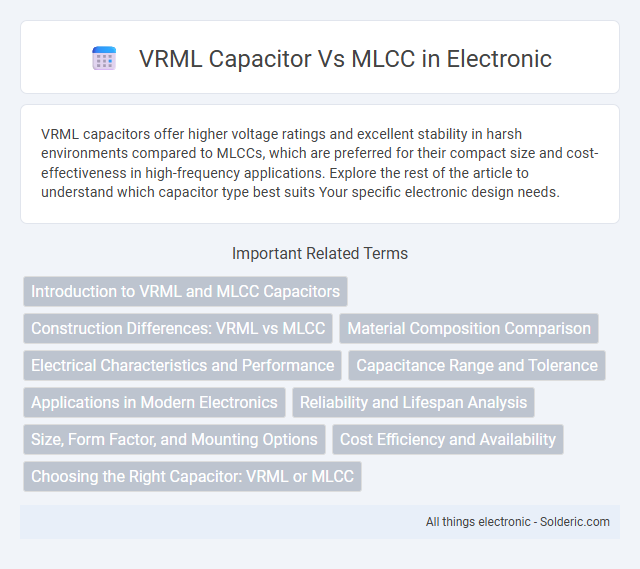VRML capacitors offer higher voltage ratings and excellent stability in harsh environments compared to MLCCs, which are preferred for their compact size and cost-effectiveness in high-frequency applications. Explore the rest of the article to understand which capacitor type best suits Your specific electronic design needs.
Comparison Table
| Feature | VRML Capacitor | MLCC (Multi-Layer Ceramic Capacitor) |
|---|---|---|
| Dielectric Material | Mica | Ceramic |
| Capacitance Range | 1 pF to 0.1 uF | 1 pF to 100 uF |
| Temperature Stability | High (+-1% to +-3%) | Varies (NP0 stable, X7R/X5R moderate) |
| Tolerance | +-1% to +-5% | +-5% to +-20% |
| Size | Larger due to mica layers | Compact, surface mount suitable |
| Voltage Rating | Up to 2000 V | Typically up to 500 V |
| ESR (Equivalent Series Resistance) | Low | Low to moderate |
| Applications | High frequency, precision circuits | General purpose, decoupling, filtering |
| Cost | Higher | Lower |
Introduction to VRML and MLCC Capacitors
VRML (Variable Resistor Multilayer) capacitors and MLCC (Multilayer Ceramic Capacitors) are essential components in modern electronics, each serving unique functions. MLCCs are widely used for their excellent capacitance stability, low cost, and high reliability in filtering and decoupling applications across various devices. VRML capacitors offer variable resistance properties alongside capacitance, making them suitable for dynamic tuning and adaptive circuit designs, enhancing Your system's performance versatility.
Construction Differences: VRML vs MLCC
VRML capacitors feature a vertical structure with stacked metal layers and ceramic dielectric, allowing for improved volumetric efficiency compared to traditional MLCCs which utilize a flat, layered arrangement. The VRML design reduces parasitic inductance by shortening the internal electrodes, enhancing high-frequency performance critical for modern electronic applications. Your choice between VRML and MLCC depends on the need for compact size, high capacitance density, and low inductance in advanced circuit designs.
Material Composition Comparison
VRML capacitors utilize a tantalum oxide dielectric, offering high volumetric efficiency and stable capacitance under varying conditions, while MLCCs (Multilayer Ceramic Capacitors) consist of ceramic dielectric layers such as barium titanate, providing excellent high-frequency performance and low equivalent series resistance (ESR). The unique material composition of VRML capacitors enables superior energy density and temperature stability, whereas MLCC materials deliver resilience to mechanical stress and broad capacitance ranges. Selection depends on application requirements, balancing dielectric constant, volumetric efficiency, and frequency response between tantalum oxide and ceramic materials.
Electrical Characteristics and Performance
VRML capacitors offer superior voltage stability and lower equivalent series resistance (ESR) compared to MLCCs, making them ideal for high-frequency applications and pulse power circuits. MLCCs excel in capacitance density and size, providing consistent performance across a wide temperature range but may suffer from piezoelectric noise and capacitance reduction under DC bias. Your choice depends on balancing VRML's enhanced electrical reliability against MLCC's compactness and cost-effectiveness in typical electronic devices.
Capacitance Range and Tolerance
VRML capacitors typically offer a narrower capacitance range, often from a few picofarads up to a few microfarads, with tolerance levels commonly around +-5% to +-20%. In contrast, MLCCs provide a broader capacitance range, spanning from a few picofarads to several hundred microfarads, and generally achieve tighter tolerances as low as +-1% to +-10%. This makes MLCCs more suitable for applications requiring precise capacitance values and greater variability in capacitance options.
Applications in Modern Electronics
VRML capacitors excel in high-frequency applications and power electronics due to their low equivalent series resistance (ESR) and thermal stability, making them ideal for power supplies and DC-DC converters. MLCCs are widely used in consumer electronics, smartphones, and automotive systems for decoupling and filtering because of their compact size and high capacitance per volume. Your choice between VRML capacitors and MLCCs should consider the specific frequency range, thermal conditions, and space constraints of your electronic design.
Reliability and Lifespan Analysis
VRML capacitors exhibit superior reliability in high-temperature and high-frequency applications compared to MLCCs, due to their robust dielectric materials and stable electrical performance under stress. MLCCs, while cost-effective and widely used, often suffer from fatigue and microcracking over time, leading to potential failure in demanding environments. Lifespan analysis shows VRML capacitors maintain capacitance and insulation resistance longer, making them ideal for critical applications requiring extended operational stability.
Size, Form Factor, and Mounting Options
VRML capacitors typically offer a compact size with a cylindrical form factor, allowing for versatile mounting options such as through-hole and surface mount, making them ideal for high-voltage applications. MLCCs (Multi-Layer Ceramic Capacitors) feature a smaller, rectangular, chip-like form factor with a low profile designed specifically for surface mount technology (SMT) to optimize PCB space. The choice between VRML and MLCC depends on requirements for size constraints, mounting method compatibility, and the specific electrical characteristics needed for the application.
Cost Efficiency and Availability
VRML capacitors generally offer higher cost efficiency compared to MLCCs due to their simpler construction and lower production costs. MLCCs provide extensive availability across various capacitance ranges and voltage ratings, making them suitable for mass production in diverse electronic applications. Choosing VRML capacitors can reduce expenses in bulk applications where high capacitance and cost-effectiveness are prioritized over size and frequency performance.
Choosing the Right Capacitor: VRML or MLCC
Choosing the right capacitor for your electronic design hinges on understanding the differences between VRML (Voltage-Resistant Multilayer) capacitors and MLCC (Multilayer Ceramic Capacitors). VRML capacitors excel in high-voltage and high-stress applications due to their superior voltage resistance and stability, making them ideal for power electronics and industrial uses. MLCCs offer compact size, excellent high-frequency performance, and cost-effectiveness, making them suitable for consumer electronics and signal filtering where space and frequency response are critical.
VRML capacitor vs MLCC Infographic

 solderic.com
solderic.com